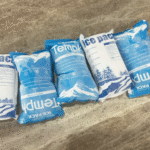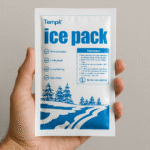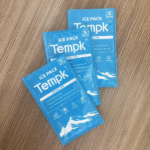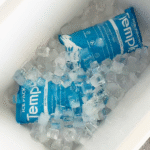Lors de l'expédition de marchandises périssables, maintaining a stable temperature is critical to ensuring product integrity. Packs de glace sec, Fabriqué à partir de dioxyde de carbone solide (Co₂), offer a powerful solution to keep items frozen during transit. As the cold chain logistics industry evolves in 2025, understanding the latest regulations, meilleures pratiques, and innovative trends in using dry ice for shipping is crucial for compliance and safety.
Que sont Packs de glace sec pour l'expédition?
Dry ice packs are sheets, blocs, or pellets of solid CO₂, designed to keep temperature-sensitive products at ultra-low temperatures. Contrairement à la glace conventionnelle, dry ice sublimates directly into gas without leaving behind any liquid residue. This feature makes it ideal for shipping items that require freezing, comme les produits pharmaceutiques, échantillons biologiques, and certain perishable foods.
Why Use Dry Ice for Shipping?
Dry ice packs are an excellent choice for shipping due to their unique properties, providing several advantages over traditional cooling methods.
-
Puissance de refroidissement durable: Dry ice sublimates at a much slower rate than regular ice, ensuring your goods remain cold for longer durations.
-
No Moisture Runoff: Since dry ice does not melt into water, there’s no risk of water damage to sensitive items.
-
Ideal for Extended Transit: Pour les expéditions qui durent plus de 48 heures, dry ice is often the preferred choice for keeping goods frozen.
2025 Regulations for Shipping Dry Ice
Shipping dry ice is subject to strict regulations due to its classification as a hazardous material. Dans 2025, the following key regulations must be adhered to when shipping dry ice:
-
Numéro de l'ONU: Packages containing dry ice must be clearly labeled with the UN number “1845.”
-
Classe 9 Étiquette de danger: Une classe 9 hazardous materials label must be affixed to the package.
-
Déclaration de poids: The net weight of dry ice in kilograms must be marked on the package.
-
Venting Requirements: Packaging must allow CO₂ gas to escape to avoid pressure buildup during sublimation.
Pour le transport aérien, L'Association internationale des transports aériens (Iata) limits the amount of dry ice per package to 2.5 kg on passenger aircraft and up to 200 kg sur les vols cargo.
Meilleures pratiques pour utiliser des packs de glace sec en expédition
To ensure the safe and efficient use of dry ice for shipping, Suivez ces meilleures pratiques:
1. Select Appropriate Packaging
-
Conteneurs isolés: Use insulated coolers or Styrofoam containers to maintain the desired temperature.
-
Emballage ventilé: Ensure the container has ventilation holes to allow CO₂ gas to escape during sublimation.
-
Cushioning: Properly secure items inside the packaging to prevent damage during transit.
2. Calculer la quantité de glace carbonique
Determine the quantity of dry ice based on the transit duration and the perishability of the goods. A common guideline is to use 2.5 kg of dry ice for every 24 heures d'expédition.
3. Étiqueter correctement les colis
-
Mark the package clearly with “Glace sèche” ou “Dioxyde de carbone, Solid.”
-
Attach the Numéro de l'ONU (1845) et Classe 9 Étiquette de danger.
-
Specify the net weight of dry ice in kilograms.
Erreurs courantes pour éviter
-
Sealed Containers: Never use airtight containers to pack dry ice; this can cause dangerous pressure buildup.
-
Étiquetage incorrect: Ensure all required labels are attached to avoid delays or rejections by shipping carriers.
-
Exceeding Weight Limits: Stick to the weight regulations to prevent violations of hazardous materials rules.
Alternatives à la glace sèche
Bien que la glace carbonique soit efficace, several alternatives may be more suitable depending on your shipment requirements:
-
Packs de gel: Reusable and non-hazardous, ideal for shorter transit times.
-
Matériaux à changement de phase (PCMS): These materials maintain specific temperature ranges and are reusable, offering a more sustainable option.
-
Packs de glace traditionnels: While cheaper, ice packs can leave water residue, marchandises potentiellement dommageables.
Sustainability and Trends in Dry Ice Shipping
Dans 2025, several emerging trends are shaping the dry ice shipping industry, focused on both environmental sustainability and technological advancements.
1. Production de glace sèche durable
Many suppliers are shifting toward environmentally friendly production methods by capturing CO₂ from industrial processes, such as ammonia synthesis, reducing the overall carbon footprint of dry ice.
2. Solutions d'emballage hybrides
Hybrid solutions combining dry ice and PCMs are gaining popularity. These packouts minimize CO₂ use while extending the cooling duration, making them more eco-friendly.
3. Smart Packaging and Tracking Technology
Innovations such as smart CO₂ sensors and QR-coded labels allow for real-time tracking of dry ice and product temperatures, ensuring better monitoring and compliance.
How to Store Dry Ice Packs for Shipping
Proper storage is essential to maximize the shelf life and effectiveness of dry ice packs:
-
Conserver dans un contenant isotherme: Use coolers or specially designed containers to slow sublimation.
-
Évitez les conteneurs scellés: Never store dry ice in airtight or sealed containers; always ensure proper ventilation.
-
Surveiller les taux de sublimation: Keep track of the rate at which dry ice sublimates to ensure the correct temperature is maintained.
Frequently Asked Questions About Dry Ice for Shipping
Q1: Combien de temps dure la glace sèche pendant l'expédition?
La glace carbonique peut durer entre 18 à 24 hours depending on the type of packaging and external conditions. Blocks of dry ice last longer than pellets.
Q2: Is dry ice safe to ship?
Oui, dry ice is safe for shipping when packaged according to safety guidelines, including proper ventilation and labeling.
Q3: La glace carbonique peut-elle être utilisée pour expédier des aliments?
Oui, dry ice is commonly used for shipping frozen and perishable foods, as long as the necessary safety measures are followed.
Conclusion et recommandations
Dry ice packs are a powerful tool for shipping temperature-sensitive products in 2025. By choosing the right supplier and adhering to best practices for packaging, stockage, et la sécurité, you can ensure that your products arrive at their destination in optimal condition.
Plan d'action:
-
Déterminez la plage de température requise for your shipment (congelé ou réfrigéré).
-
Calculez la quantité correcte de glace sèche basé sur la durée de l'expédition.
-
Verify regulatory compliance and ensure proper packaging and labeling.
-
Consider hybrid packaging solutions to improve sustainability and cost-efficiency.
À propos du tempk
Le tempk est un principal fournisseur de solutions d'emballage de chaîne froide, offering high-quality dry ice and other thermal control products to ensure the safe and efficient transport of temperature-sensitive goods. We specialize in helping businesses optimize their logistics while adhering to all relevant safety and regulatory standards.
Contactez Tempk dès aujourd'hui to learn more about our dry ice solutions and how we can help streamline your cold chain shipments.























